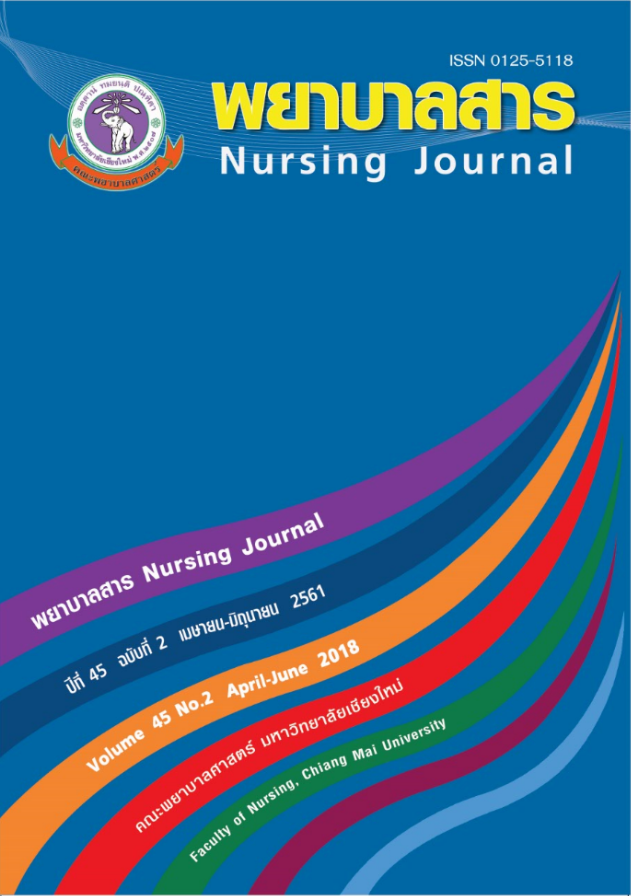Factors Related to Maternal Health Education of Nurses for Promoting Infants Development
Keywords:
Health education, promoting development of 0-2 months old infants, knowledge, factors, and nursesAbstract
Promotion of infant development is unlikely to be focused on the first 2 months of age. This descriptive study aimed to explore health education of mothers for promoting development of 0-2 months old infants and related factors. The subjects were 293 professional nurses in Chiang Mai who worked with postpartum mothers and/or 0-2 months old infants. The results revealed that the average score of health education was 51.54/100 (SD=20.31), which felt into the moderate level from 5 levels of very low, low, moderate, high, and very high. Among 4 categories of health education, the average scores of all categories were significantly different. Category 1: informing risks and severity of delayed fetal development was at the lowest level, followed by category 4: cue to action by telling how to do, demonstration, being a role model, using audiovisual aids, and giving printed materials, category 2: informing benefits of promoting fetal development, and category 3: informing no barriers. Through t-test or Mann Whitney U test, higher scores of health education were found in the following groups: female, 41-60 years old, having children, having ever obtained training about child development, or having the score of knowledge on promoting infant development > 60/100.
Nurses should be enhanced in their health education skills about infant development, especially those who are male, young, have no children, or have low knowledge, still need improvement of their health education skills. Training should be emphasized on giving information about risks and severity of delayed fetal development. In addition, health education plans, audiovisual aids, as well as printed materials for mothers should be developed.
References
กระทรวงสาธารณสุขและภาคีเครือข่ายด้านพัฒนาการเด็ก. (2559). การคัดกรองพัฒนาการเด็กผ่าน HDC. http://hpc5.anamai.moph.go.th/director/dspm/index.php สืบค้นวันที่ 9 เมษายน 2560.
กลุ่มอนามัยแม่และเด็ก สำนักส่งเสริมสุขภาพ กรมอนามัย กระทรวงสาธารณสุข. (2557). สมุดบันทึกสุขภาพแม่และเด็ก. กรุงเทพฯ: โรงพิมพ์องค์การสงเคราะห์ทหารผ่านศึก.
เกสรา ศรีพิชญาการ, พรรณพิไล ศรีอาภรณ์, และ ปิยะนุช ชูโต. (2558). ผลการเรียนรู้ของนักศึกษาพยาบาลในการให้สุขศึกษามารดาเกี่ยวกับการส่งเสริมพัฒนาการของทารก. พยาบาลสาร, 42(ฉบับพิเศษ), 116-128.
จินตนา พัฒนพงศ์ธร, ชัยชนะ บุญสุวรรณ, และนฤมล ธนเจริญวัชร. (2558). การศึกษาพัฒนาการเด็กปฐมวัยไทย ปี 2557. อ้างใน กระทรวงสาธารณสุขและภาคีเครือข่ายด้านพัฒนาการเด็ก. http://inspection.anamai.moph.go.th/uploads/docs/g1/JP02_TheStudyOfThaiEarlyChildDevelopmen.pdfสืบค้นวันที่ 9 เมษายน 2560.
จินตนา ยูนิพนธ์. (2540). การพยาบาลจิตเวช เล่ม 2. กรุงเทพฯ: โรงพิมพ์จุฬาลงกรณ์มหาวิทยาลัย.
ดลก์พร มาตยาบุญ, พิมพาภรณ์ กลั่นกลิ่น, และมาลี เอื้ออำนวย. (2559). การปฏิบัติของพยาบาลและปัจจัยที่เกี่ยวข้องในการดูแลเพื่อส่งเสริมพัฒนาการทารกเกิดก่อนกำหนด. พยาบาลสาร, 43(4), 1-11.
บุญใจ ศรีสถิตนรากูร. ( 2550). ระเบียบวิธีการวิจัยทางการพยาบาล. กรุงเทพฯ:ยูแอนด์ไอ อินเตอร์ มีเดีย. กรุงเทพฯ: เอส. พี. เอ็น.
สถาบันพัฒนาการเด็กราชนครินทร์. (2558). คู่มือเฝ้าระวังและส่งเสริมพัฒนาการเด็กปฐมวัย (DSPM). Download from www.thaichilddevelopment.com.
สุปรียา ตันสกุล. (2550). ทฤษฎีทางพฤติกรรมศาสตร์ : แนวทางการดำเนินงานในงานสุขศึกษา
และส่งเสริมสุขภาพ. วารสารสุขศึกษา, 30(105), 1-15.
Blackburn, S. T. (2003). Maternal, fetal, and neonatal physiology: A clinical perspective (2nd ed.). St Louis: Elsevier.
Cohn, J. F., & Tronick, E. Z. (1988). Mother-infant fact-to-fact interaction: Influence is directional and unrelated to periodic cycles in either partner’s behavior. Developmental Psychology, 24(3), 386-392.
Harmon, K. (2010). How important is physical contact with your infant? https://www.scientificamerican.com/article/infant-touch/
Hudson, D. B., Elek, S. M., & Fleck, M. O. (2001). First-time mothers' and fathers' transition to parenthood: infant care self-efficacy, parenting satisfaction, and infant sex. Issues in Comprehensive Pediatric Nursing, 24(1), 31-43.
Murray, S. S., & McKinney, E. S. (2010). Foundataions of maternal-newborn and women’s health nursing (5thed.). Maryland Heights, Missouri: Saunders.
Rochat, P. R. (2001). Social contingency detection and infant development. Bulletin of Menninger Clinic, 65(3), 347-360.
Solkowski, C. (2015). 9 Ways males and females differ in parenting skills. https://storify.com/clairesolkowski/20-ways-males-and-females-can-both-be-effective-si
Stanton, G. (2004). The involved father. http://www.focusonthefamily.com/parenting/parenting-roles/the-involved-father/fathers-matter
Tappero, E. P., & Honeyfield, M. E. (2003). Physiological assessment of the newborn: A comprehensive approach to the art of physical assessment (3rd ed.). Santa Ross, CA: NICU INK Book Publishers.
Tavassolie, T., Dudding, S., Madigan, A.L., & Thorvardarson, A. W. (2016). Differences in perceived parenting style between mothers and fathers: implications for child outcomes and marital conflict. Journal of Child and Family Studies, 25(6), 2055–2068.
Wilson, D. (2009). Health promotion of the infant and family. In M. J. Hockenberry & D. Wilson (Eds.), Wong’s essentials of pediatric nursing (8th ed.), pp. 322-376. St. Louis: Mosby.
Downloads
Published
How to Cite
Issue
Section
License
บทความที่ได้รับการตีพิมพ์เป็นลิขสิทธิ์ของวารสารพยาบาลสาร
ข้อความที่ปรากฏในบทความแต่ละเรื่องในวารสารวิชาการเล่มนี้เป็นความคิดเห็นส่วนตัวของผู้เขียนแต่ละท่านไม่เกี่ยวข้องกับมหาวิทยาลัยเชียงใหม่ และคณาจารย์ท่านอื่นๆในมหาวิทยาลัยฯ แต่อย่างใด ความรับผิดชอบองค์ประกอบทั้งหมดของบทความแต่ละเรื่องเป็นของผู้เขียนแต่ละท่าน หากมีความผิดพลาดใด ๆ ผู้เขียนแต่ละท่านจะรับผิดชอบบทความของตนเองแต่ผู้เดียว






